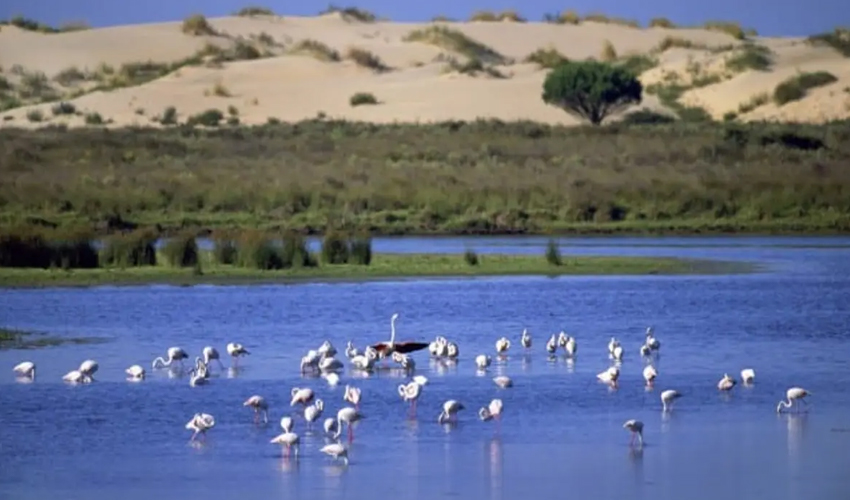Donana National Park

The Doñana National Park is located in the fertile river delta where the Guadalquivir meets the Mediterranean Sea. It is an ecological paradise of sand dunes, marshes and plains that serves as a refuge for many species of wildlife. Birders will be treated to views of thousands of different African migratory species. More local endangered species can also be seen by lucky people, like the Iberian lynx and the Spanish Imperial Eagle. As it was once a home for nobility, the visitors centers and marine museum are all housed in repurposed castles and manors, and are worth seeing as well.
Within Doñana you'll come across the famous white village of El Rocío, a meeting point for hundreds of lay brotherhoods during the procession of El Rocío, one of the most famous and popular in Spain (held between May and June). Another iconic event takes place on 26 June, in a tradition dating back more than 500 years, when the Almonte ranchers organise the Saca de Yeguas, rounding up the wild horses you can see grazing in the National Park.While you're here, make sure to explore tourist destinations like Huelva, La Rábida and its Muelle de las Carabelas, Sanlúcar de Barrameda and Moguer, and try local specialities like white prawns from Huelva or Iberian ham. There are also other worthwhile natural spaces nearby, such as Sierra de Aracena y Picos de Aroche Natural Park, and the Rio Tinto Mining Park.
Changing scenery with thousands of birds
Doñana is one of Europe's most beautiful and important wetlands. What makes this national park so special is that in just one day you can see very different ecosystems: marshland, lagoons, pine groves, aloe veras, moving dunes, cliffs, 30 kilometres of unspoiled white beaches... A natural spectacle that is different each season, between the Andalusian provinces of Huelva, Seville and Cadiz.What you will find
Exploring the protected paths around Doñana gives you the chance to see some of the most endangered species on the planet, like the Spanish imperial eagle and the Iberian lynx. Doñana is home to more than 230 species of birds and you might be lucky enough to see breathtaking scenes such as the "pink carpet" that the flamingo colonies create when they feed. In fact, the marshlands are a staging, breeding and wintering site for thousands of European and African birds.Among the varied landscapes, you'll be amazed at natural phenomena like the mobile dunes (some over 30 metres high) which move from the beach and bury all the pine groves in their path.Routes around the Park
If you fancy exploring the Park on your own, you can get information at any of the visitor centres, and you will find paths, walkways, bike trails, observatories and much more. But if you really want to immerse yourself in all its ecosystems, and truly get to know them, you should book an off-road guided tour, bicycle tour, horse riding excursion along the beach at sunset, photography or ornithology course. One particularly special way of getting to know Doñana is to board the tourist boat, the Real Fernando, which cruises up the last section of the Guadalquivir river.Within Doñana you'll come across the famous white village of El Rocío, a meeting point for hundreds of lay brotherhoods during the procession of El Rocío, one of the most famous and popular in Spain (held between May and June). Another iconic event takes place on 26 June, in a tradition dating back more than 500 years, when the Almonte ranchers organise the Saca de Yeguas, rounding up the wild horses you can see grazing in the National Park.While you're here, make sure to explore tourist destinations like Huelva, La Rábida and its Muelle de las Carabelas, Sanlúcar de Barrameda and Moguer, and try local specialities like white prawns from Huelva or Iberian ham. There are also other worthwhile natural spaces nearby, such as Sierra de Aracena y Picos de Aroche Natural Park, and the Rio Tinto Mining Park.

 Spanish
Spanish German
German Dutch
Dutch